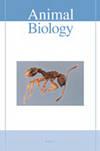On the behavioural biology of a morpho-variant of Myrmaplata plataleoides (O. Pickard-Cambridge, 1869) (Araneae: Salticidae) with taxonomic notes
IF 0.9
4区 生物学
Q2 ZOOLOGY
引用次数: 0
Abstract
We hereby report an isolated population of a rare morpho-variant of the ant-mimicking jumping spider Myrmaplata plataleoides (O. Pickard-Cambridge, 1869) from Hazaribagh Wildlife Sanctuary, Hazaribagh, Jharkhand, India, which is also the first record of this species from the state of Jharkhand, India. Descriptions of both male and female spiders, the female’s exuviae, its eggs and habitat are presented. We have studied its moulting, feeding and sexual behaviour in detail, and have recorded various behavioural aspects that were never documented before, such as debris-rolling behaviour, photokinetic response, starvation response and oxygen deprivation response. We here report the occurrence of this spider near the colonies of the ground-nesting ant Camponotus compressus (Fabricius, 1787). This spider is known to mimic the Asian weaver ant Oecophylla smaragdina (Fabricius, 1775), which are greenish orange to red in colour. Specimens collected by us are dark brown to black in coloration whereas the commonly reported specimens are often greenish orange to red. We propose that the darker coloration would have been naturally selected in this isolated population of M. plataleoides as an adaptation to coexist with C. compressus, which is also black in coloration and abundant around the spiders. Study of the moulting behaviour of the morpho-variant further reveals the display of a novel mechanism of ant mimicry among these spiders which we have named as temporal myrmecomorphy. Temporal myrmecomorphy has been proposed to be a protective mechanism used by a harmless mimic against the attacks of the aggressive models so that it can co-exist with the models. Present study establishes the usefulness of a morpho-variant as an important model in understanding the evolution and behaviour of a species holistically.(蜘蛛目:水蛛科)一形态变异的行为生物学及分类注释
我们在此报告了来自印度贾坎德邦哈扎里巴格野生动物保护区的一个罕见形态变异的仿蚁跳蛛Myrmaplata plataleoides(O.Pickard Cambridge,1869)的孤立种群,这也是印度贾坎德邦首次记录到该物种。介绍了雄性和雌性蜘蛛、雌性的蜕皮、卵和栖息地。我们详细研究了它的换羽、进食和性行为,并记录了以前从未记录过的各种行为方面,如碎片滚动行为、光动力学反应、饥饿反应和缺氧反应。我们在这里报道了这种蜘蛛在地面筑巢蚂蚁Camponotus compressus(Fabricius,1787)的群落附近出现的情况。众所周知,这种蜘蛛模仿亚洲织蚁Oecophylla smaragdina(Fabricius,1775),其颜色从绿橙色到红色。我们收集的标本颜色从深棕色到黑色,而通常报道的标本通常是绿橙色到红色。我们认为,在这个孤立的扁蛛种群中,较深的颜色是自然选择的,以适应与压缩扁蛛共存,压缩扁蛛也是黑色的,在蜘蛛周围大量存在。对形态变体换羽行为的研究进一步揭示了这些蜘蛛中蚂蚁模仿的一种新机制,我们将其命名为颞蚁形态。暂时性myrmecomorphy被认为是一种保护机制,由无害的模拟物用于对抗攻击性模型的攻击,从而可以与模型共存。目前的研究证实了形态变体作为一个重要模型在全面理解物种进化和行为方面的有用性。
本文章由计算机程序翻译,如有差异,请以英文原文为准。
求助全文
约1分钟内获得全文
求助全文
来源期刊

Animal Biology
生物-动物学
CiteScore
2.10
自引率
0.00%
发文量
34
审稿时长
3 months
期刊介绍:
Animal Biology publishes high quality papers and focuses on integration of the various disciplines within the broad field of zoology. These disciplines include behaviour, developmental biology, ecology, endocrinology, evolutionary biology, genomics, morphology, neurobiology, physiology, systematics and theoretical biology. Purely descriptive papers will not be considered for publication.
Animal Biology is the official journal of the Royal Dutch Zoological Society since its foundation in 1872. The journal was initially called Archives Néerlandaises de Zoologie, which was changed in 1952 to Netherlands Journal of Zoology, the current name was established in 2003.
 求助内容:
求助内容: 应助结果提醒方式:
应助结果提醒方式:


